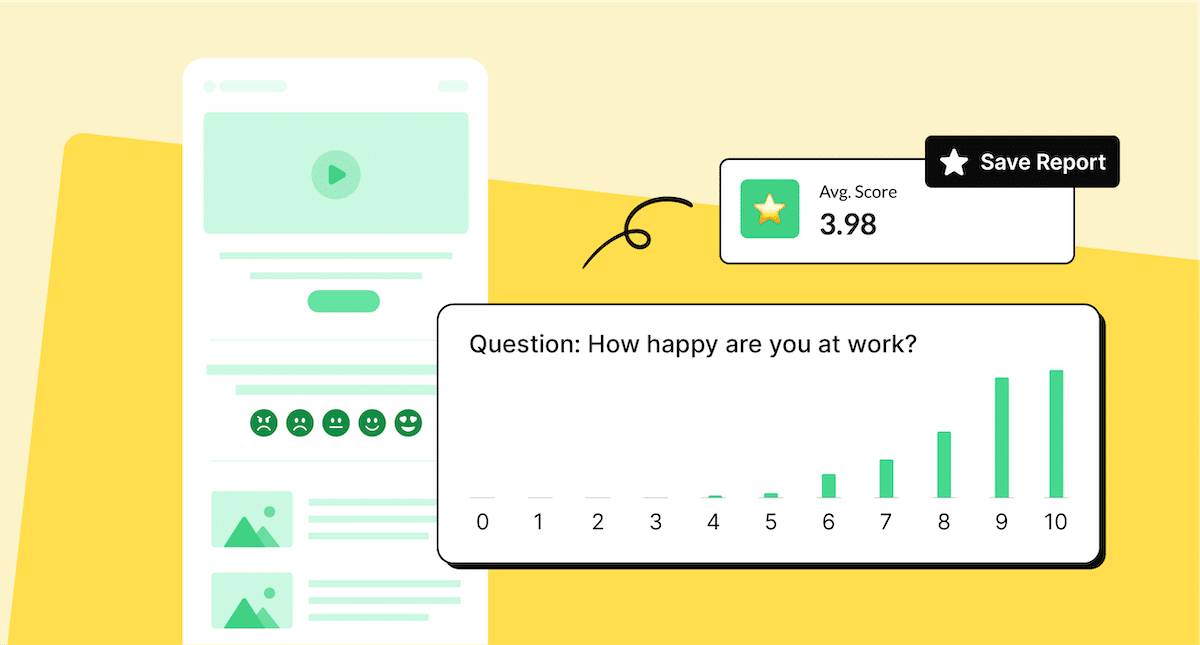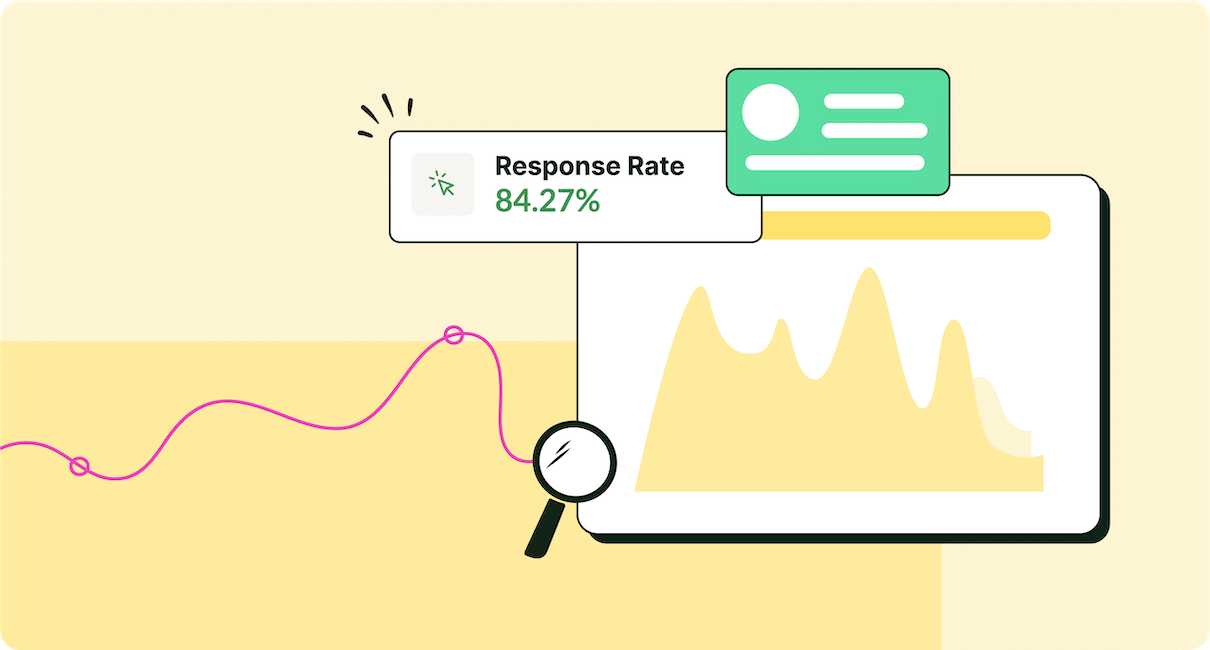Staying connected with your employees is more important than ever. Enter the employee pulse survey—a dynamic tool that’s revolutionizing the way organizations gather timely feedback and engage with their workforce. Here’s how to use these surveys to improve your internal communications.
The importance of employee pulse surveys in internal communications cannot be overstated. They are a vital link between management and employees, creating a channel for honest, real-time feedback.
Pulse surveys offer a more agile approach to feedback, allowing companies to quickly gauge employee opinions on various topics, from recent changes in company policy to satisfaction with leadership. This frequent feedback loop enables organizations to address issues promptly and fosters a culture of continuous improvement and open communication.
By implementing regular pulse surveys, companies can:
- Track progress on ongoing initiatives
- Measure the impact of recent changes or decisions
- Boost employee engagement by showing that their opinions matter
In this post, we’ll explore how to use pulse surveys in your internal communications strategy and leverage the results to drive meaningful change in your organization. Whether you’re new to surveys or looking to optimize your existing strategy, understanding these powerful pulse survey tools is key to enhancing your internal communications and building a more engaged, productive workforce.
Take a self-guided tour of ContactMonkey
See how our key features can streamline your internal communications.
Take product tour

What Is a Pulse Survey?
A pulse survey is a short survey designed to gather real-time employee feedback from employees on various aspects of their work experience. This may include concise questions around job satisfaction, company culture, or specific initiatives. Unlike traditional surveys that are long and infrequent, pulse surveys are punchy and conducted on a regular basis—weekly, monthly, or quarterly. This helps to track results and employee engagement metrics and KPIs over time.
Length is a critical factor in pulse survey design. Keep your pulse surveys short and focused, ideally containing 5-10 questions that can be completed in under five minutes. This brevity encourages higher participation rates and more frequent survey administration.
Why Use Employee Pulse Surveys?
The goal of a pulse survey is to perform an organization “pulse check”. This means gathering speedy, real-time insights into employee sentiment and engagement. The information collected from pulse surveys help companies to assess and improve the work environment, employee engagement, and overall job satisfaction.
Employee pulse surveys excel at identifying trends quickly, enabling organizations to spot patterns in employee sentiment or potential problems before they escalate. This proactive approach to posting and responding to internal communication survey questions allows management to address concerns swiftly.
But why should your organization consider implementing these surveys regularly? Here are the key benefits:
- Gather real-time feedback for proactive management
- Enhance employee job satisfaction
- Foster a culture of open communication and honesty
- Engage remote and hybrid employees
- Measure the impact of organizational changes
By regularly seeking input from staff, organizations demonstrate that they value employee opinions, fostering a culture of open communication. This approach leads to higher levels of job satisfaction and loyalty, as employees feel more connected to the company’s decision-making processes. Learn more in our in-depth guide on the top benefits to employee pulse surveys.
Create and send employee surveys for feedback
Engage staff with pulse surveys, eNPS surveys, reusable surveys, custom polls, and more. Ready to send modern emails?
Explore survey features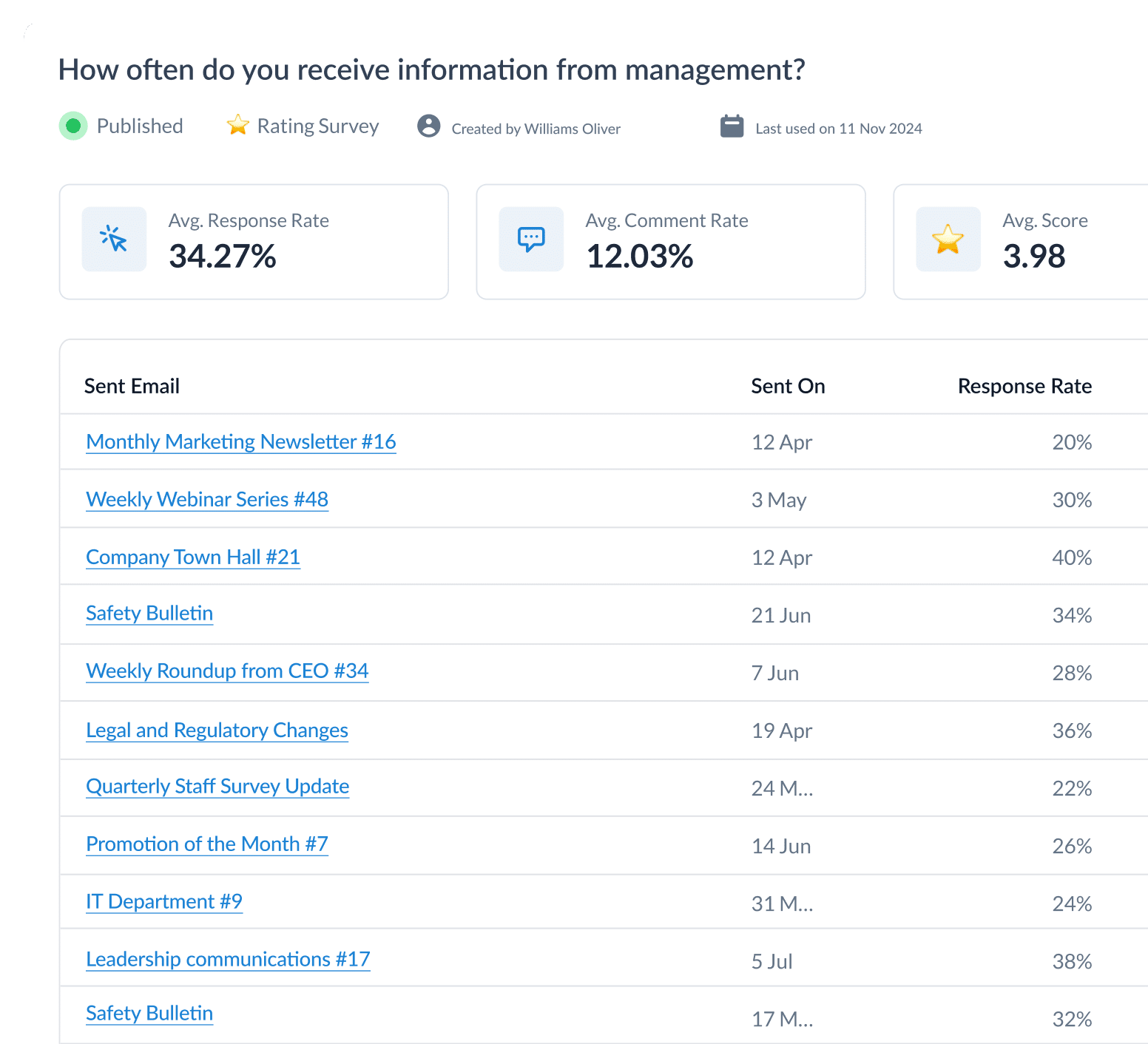
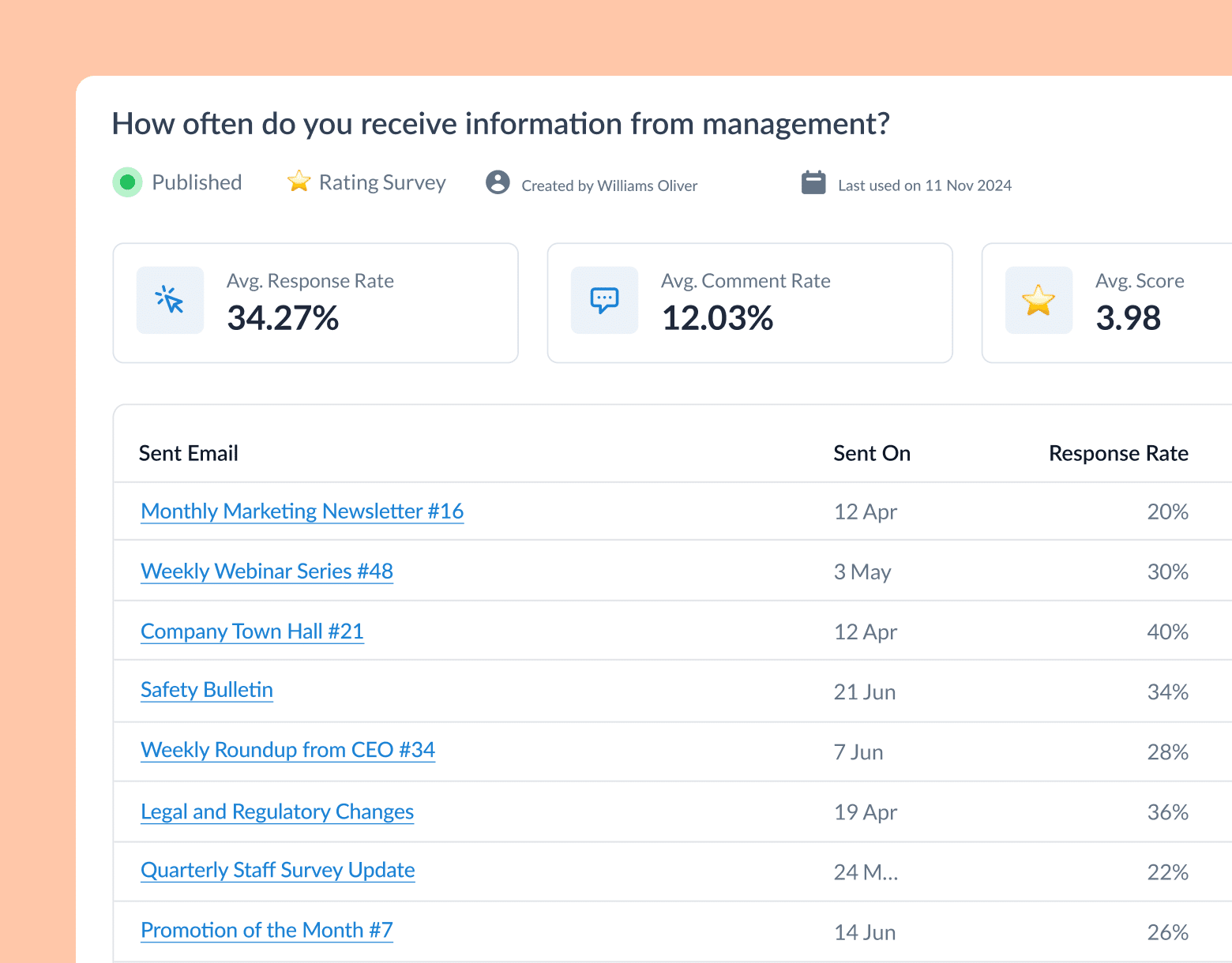
Do I Need a Special Pulse Survey Tool?
In the era of data-driven decision-making, engagement pulse surveys have emerged as a vital tool for organizations, large and small.
But, how do you know which pulse survey tool is right for your company?
There are many different types of survey and employee feedback tools to choose from. However, many types of pulse survey software require employees to install additional software, adding extra steps to complete the surveys. Your employees’ time is valuable, so the longer it takes to fill out a survey, the less likely your team will engage with it.
ContactMonkey’s pulse survey tool integrates directly with your existing email platform, like Outlook or Gmail, making it convenient and easy to use. There’s no need for any software downloads or complicated setups—just design your employee pulse survey and send it out with your regular internal communications.
On top of that, our email template generator allows you to embed pulse surveys directly into your HTML emails. All you need to do is drag and drop your survey details in your email template, choose the type of survey you want, and insert your questions.
You can customize and resize your employee pulse surveys to fit into any newsletter or email layout, while incorporating your company’s branding. Whether you want to gauge employee satisfaction, track changes in employee sentiment over time with recurring surveys, or gather immediate feedback on the success of a new initiative, the tool allows you to tailor questions to focus on what matters most. Could it get any easier?
10 Ways to Use Employee Pulse Surveys With Examples
We’ll outline ten effective ways you can use employee pulse surveys and break down how a pulse survey tool, like ContactMonkey, can help you get the most of your internal communications.
1. Assess feedback on leadership and management
Assessing how your team feels about management through employee pulse surveys is a crucial aspect of understanding employee satisfaction and identifying areas where leadership can improve.
Your employee pulse survey results are only as effective as the questions you ask your employees. So, it’s important to keep your questions concise yet meaningful.
With a survey tool like ContactMonkey, you can create custom pulse survey templates for your leadership pulse checks. Templates allow you to save survey designs and reuse questions, saving you time when building new surveys. Choose from multiple types of pulse surveys including emoji reactions, star ratings, eNPS, yes/no questions, and more. You can even give employees the option to add anonymous comments alongside their survey response.
By making your pulse surveys fun, you’re more likely to keep your employees engaged—which is key for gathering feedback on managerial effectiveness and reducing survey fatigue for your employees.
Here are some employee pulse survey questions to start gathering baseline feedback:
- How clearly does your manager communicate expectations and goals?
- How confident are you in the leadership team’s ability to navigate challenges?
- How comfortable do you feel approaching your manager with questions or concerns?
- How often does your manager keep you informed about changes that affect your work?
- How effectively does your manager communicate team goals and objectives?
Watch ContactMonkey LIVE in action
Join live demo
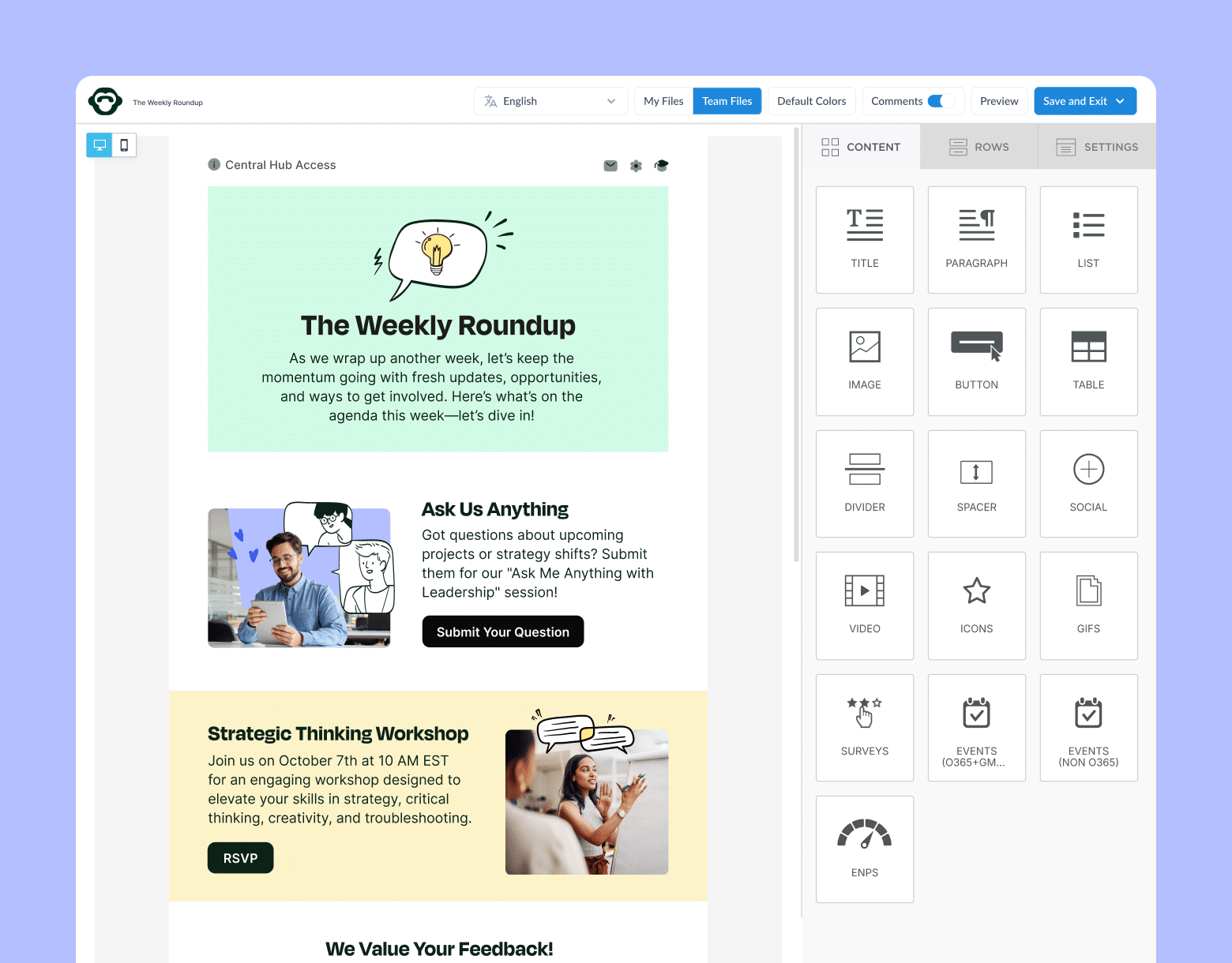
2. Evaluate employee engagement and satisfaction
With the help of employee pulse surveys, you can get a better look at how your employees are engaging with your organization. Are they feeling satisfied in their roles? Are they motivated? Do they look forward to going to work?
With ContactMonkey’s pulse survey tools, you can use employee net promoter score surveys to better understand your employees’ overall engagement. From here, it’ll calculate the scores for you and give you quantifiable survey results. Simply embed your pulse surveys right into your Outlook or Gmail newsletters and surveys and begin tracking eNPS.
For instance, you can ask employee engagement pulse survey questions like:
- How likely are you to recommend your workplace to others?
- Do you feel a personal sense of accomplishment in your work?
- How motivated are you to do your best work every day?
- Do you feel a sense of pride working for this organization?
- How would you rate the overall work environment in your team?
3. Foster a culture of recognition and praise
Cultivating a culture of recognition using pulse surveys involves consistently gathering feedback, acting on it, and creating an environment where employees feel valued and appreciated. By regularly sending out employee pulse surveys, you can track changes in how employees perceive recognition within the organization and identify any trends or areas needing improvement.
Look at the data from your pulse surveys to identify departments, teams, or demographics where employees feel under-recognized. This can help you pinpoint specific areas where recognition practices might be lacking.
If you see trends where different workplace demographics are receiving less recognition than others, you can tailor and personalize your pulse surveys with audience segmentation.
But, how do you even segment your audiences?
First thing’s first, gather the data from your pulse survey results and define your audience personas. Based on this information, you can create profiles based on different departments, teams, job roles, and demographics. With the help of ContactMonkey’s audience segmentation for internal communications tool, you can manage your email lists and monitor email segmentation stats.
Next, personalize and craft tailored employee pulse survey questions to focus on recognition, especially for employees who feel it’s lacking in the workplace. With ContactMonkey’s email template builder, you can customize your employee pulse surveys to include any updated questions or messaging.
Here are some sample employe recognition pulse survey questions:
- How often do you feel recognized for your contributions?
- What types of recognition or appreciation are most meaningful to you?
- Can you share an example of when a team member went above and beyond?
- How can we improve the way we recognize employee achievements?
- Do you feel your efforts are acknowledged by your manager/team?
4. Identify training and development needs for employees
Continuous learning and development are pivotal for both employee satisfaction and organizational success. But how do you know if your training programs are hitting the mark?
Employee pulse surveys are a powerful tool for uncovering gaps and opportunities in your team’s skills and knowledge, and how you can leverage these insights to foster a culture of growth and ongoing learning.
For example, let’s say you want to encourage your teams to sign up for an in-person training program during office hours, you can send out an employee pulse survey to gauge employee interest. Our email builder tool lets you choose from dozens of beautifully designed templates. You can even create events and add event registration boxes—making it easy for employees to sign up.
Here are some example training and development questions you can include in your next employee pulse survey:
- Would you participate in training programs at the workplace?
- How satisfied are you with the current training and development opportunities offered by the organization?
- Are there any skills or knowledge areas where you feel additional training is needed?
- Would you be interested in cross-training or learning skills from other departments?
- How likely are you to recommend our training programs to a colleague?
For a deeper dive into training and development emails, check out our post.
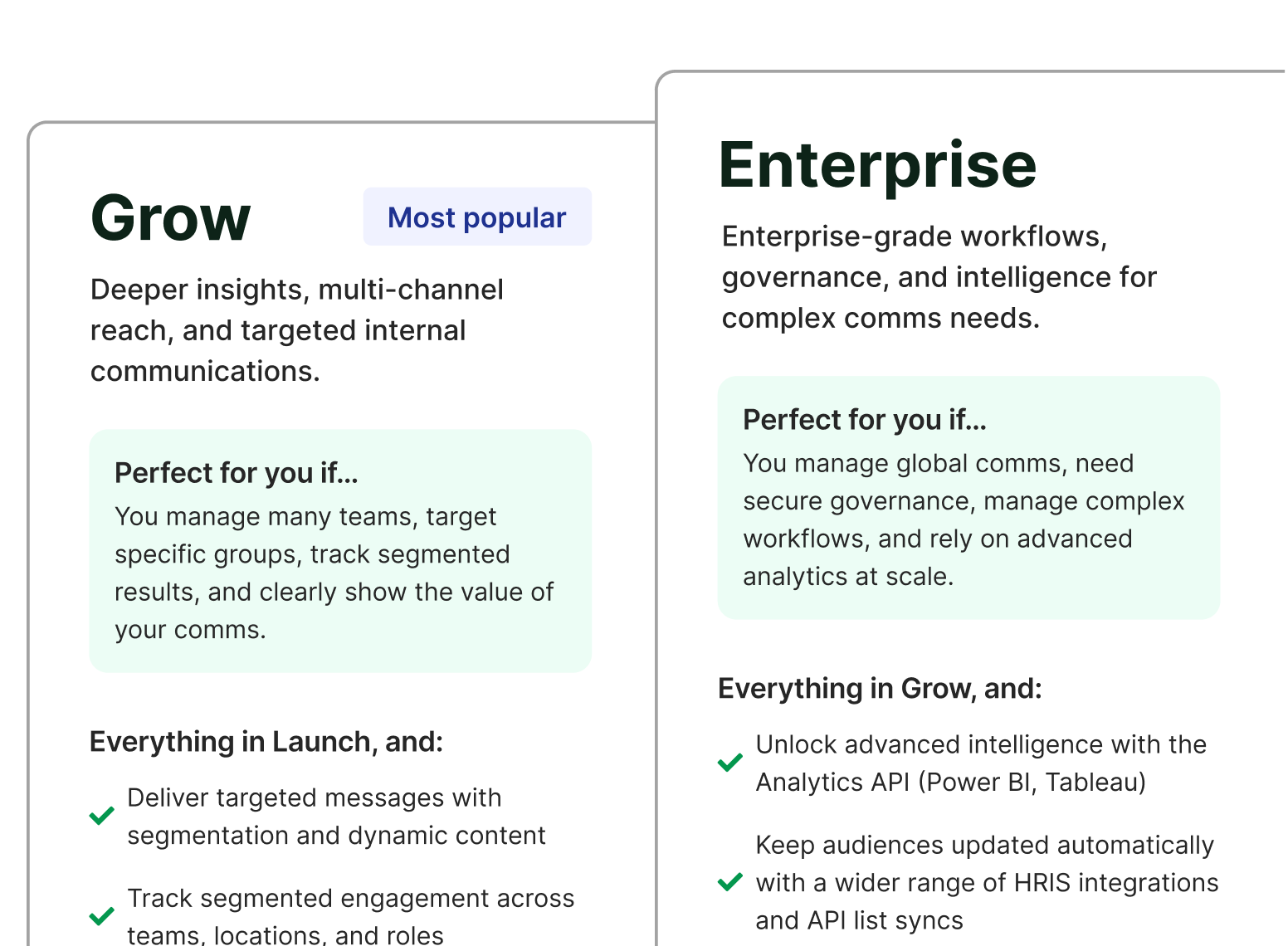
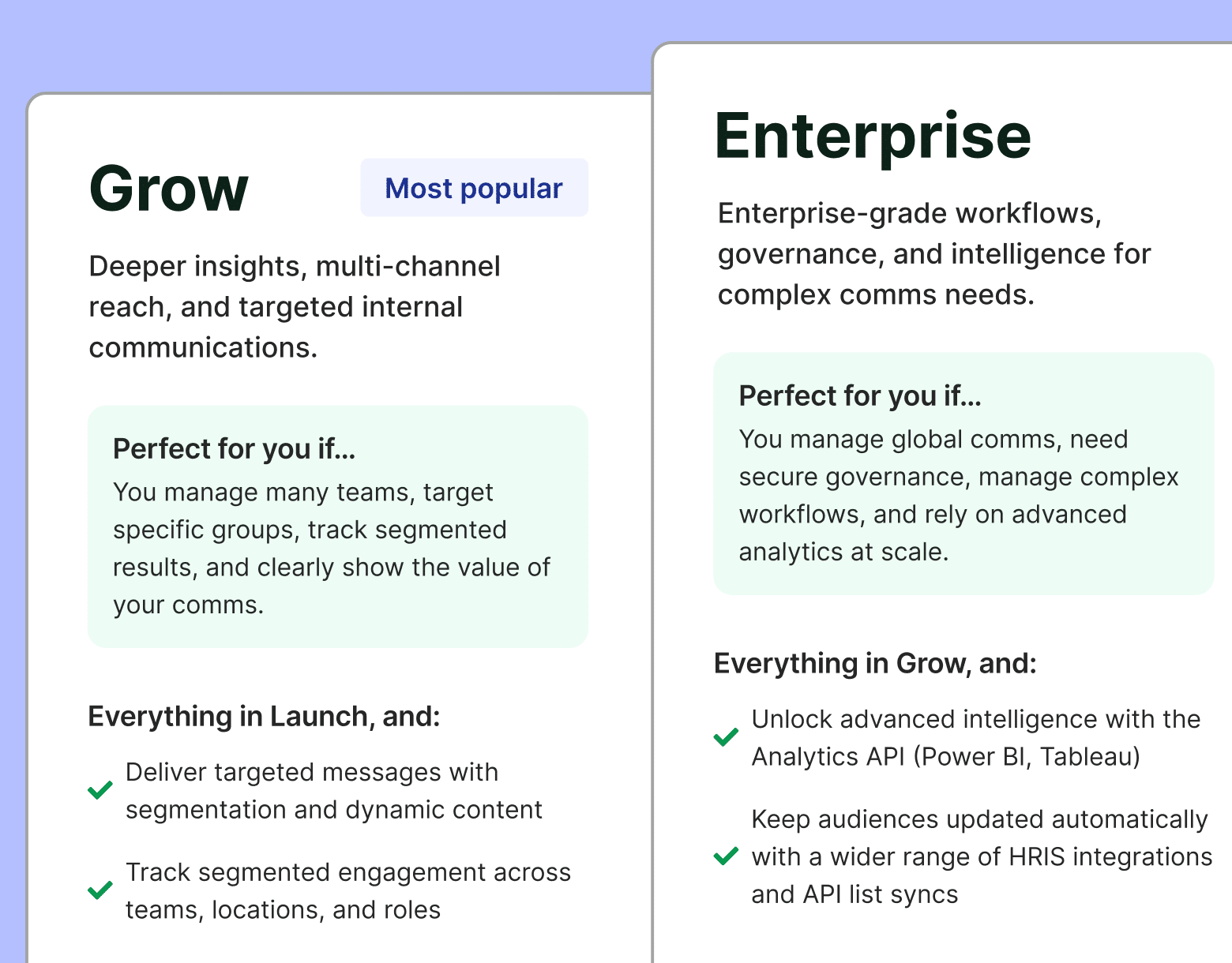
5. Gauge the quality of your employees’ remote work experience
The shift to largely remote and hybrid work has transformed the way we operate, bringing with it unique challenges and opportunities. Without daily interactions and frequent check-ins, remote employees can feel isolated, disconnected, and even stressed. Monitoring their experience helps you identify challenges early, allowing you to provide the necessary resources to keep your team happy and productive.
There’s no one-size-fits-all approach to gathering data on your employees’ remote work experience—especially with employee pulse surveys. With ContactMonkey, we offer different internal communication channels like email and a Microsoft Teams integration. To ensure your employees engage with your content, try implementing emojis, interactive polls, star scales, or thumbs up or down reacts.
Here are some employee pulse survey examples of questions you can ask your remote employees:
- How connected do you feel to your team while working remotely?
- How would you rate your current work-life balance?
- How clear are the expectations for your remote work hours and availability requirements?
- What additional support or training would help you be more successful in your role?
- What is your preference for future work arrangements (full-time remote, hybrid, or in-office)?
6. Gather feedback on new organizational initiatives
Organizational changes—whether they include new policies, programs, or managerial changes—can significantly impact employee engagement and productivity. To ensure initiatives are effective and well-received, it’s important to collect timely and relevant feedback.
For instance, if you make updates to your diversity, equity, and inclusion (DEI) policies, you can use an employee pulse survey to ensure transparency from leaders and gather immediate feedback from your teams. Ask your employees how they feel about the changes. What does DEI in the workplace mean to them? How did the change implementation impact their work?
Here are some sample questions you can use for your pulse surveys:
- How frequently would you prefer updates or check-ins about the new [initiative]?
- What additional support or resources would help you better adapt to the new [initiative]?
- How satisfied are you with the new [initiative]?
- Have you experienced any challenges integrating the new [initiative] into your daily work?
- How well do you understand the purpose and goals of the new [initiative]?
Read our detailed post about how to create an effective pulse survey.
7. Facilitate change management in the organization
Change is an inevitable part of any organization’s growth and development. Resistance from employees, communication gaps, and the fear of the unknown can hinder the smooth transition from old to new. To overcome these challenges, organizations need a robust mechanism to gather feedback and gauge employee sentiment.
For example, if your organization is undergoing a significant restructuring, a change management pulse survey can help you understand how employees are reacting to the changes. Are they anxious? Confused? Excited? By knowing the overall sentiment, you can address concerns proactively and adjust your change management strategy accordingly.
Here are some effective change management pulse survey questions you can use:
- How confident do you feel about the upcoming changes in our organization?
- What improvements would you suggest to make the change smoother?
- On a scale of 1-10, how confident are you that the change will be successful?
- How likely are you to recommend our current change management approach to others?
- Do you feel supported by your manager/team during this change?
Start two-way conversations and employee feedback loops
Learn how to engage staff with pulse surveys, content ratings and reactions, custom polls, and more. Ready to send modern emails?
See engagement features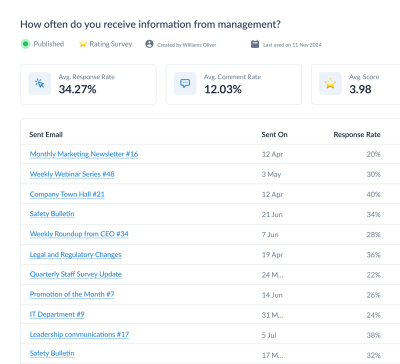

8. Anticipate employee turnover risks
Employee turnover is a reality that every organization faces, but its effects can ripple across the entire company, influencing everything from morale to the bottom line. While some turnover is inevitable—and even healthy—excessive turnover can be detrimental.
Monitoring employee turnover rates through employee pulse surveys involves a strategic approach to regularly gather, analyze, and act on feedback that can predict and reduce turnover.
For example, let’s say your top salesperson leaves your organization and works for a competitor. Because your top employee cultivated strong relationships with your clients, these clients may switch services and follow them to a competing organization.
To avoid this type of scenario, you can use employee pulse surveys to check in on your staff. Are they satisfied with their roles? Are they burnt out? Do they feel supported? Getting the answers to these questions will help you understand how to retain your high-performing talent.
Here are example pulse survey questions you can use to monitor employee turnover:
- What factors might influence your decision to leave the company?
- How likely are you to look for a new job within the next six months?
- How would you rate your work-life balance?
- If you were to leave, what would be the primary reason?
- What could the company do to increase your likelihood of staying?
9. Measure employee job satisfaction
Happy and satisfied employees are not just a sign of a healthy workplace; they are a key driver of business success. When employees are satisfied, they contribute more effectively, leading to numerous benefits for the organization.
For example, let’s say you’ve hired new staff at your organization and you want to see how they’re feeling after their first few weeks. Send out employee pulse surveys every two weeks and ask how they feel about the onboarding process, their teams, and their new tasks. By sending out short surveys at the beginning or end of each week, your new hires will know they can submit their feedback whenever they have questions or comments.
Try these employee satisfaction questions in your next employee pulse survey:
- How likely are you to recommend our organization as a great place to work?
- How would you rate the physical work environment?
- Do you feel recognized and appreciated for your contributions?
- How often do you feel you have the freedom to innovate or try new approaches in your work?
- How would you rate the communication from your manager?
10. Check employee team dynamics in the workplace
The strength of your team can make or break your organization. Team dynamics—the way individuals in a group interact, communicate, and work together—are essential to achieving shared goals. However, team dynamics can be challenging to assess and improve without regular, targeted feedback from the team members themselves.
This is where employee pulse surveys come in as a game-changing tool.
For instance, imagine a marketing agency that has recently restructured its teams to better align with client needs. After the restructuring, the agency may choose to use pulse surveys to monitor how the changes are affecting team dynamics.
Let’s say you asked your team in a pulse survey, “Do you feel your new team is communicating effectively?”. The pulse survey results showed that while most employees felt positive about the restructuring, several felt that communication was fragmented, leaving some employees feeling out of the loop.
Based on this feedback, the leadership team could organize a series of team-building workshops focused on improving communication and collaboration. They could also implement regular check-in meetings where team members could share updates and address any concerns.
Here are some employee pulse survey questions you can use to monitor team dynamics:
- Do you feel that communication within your team is open and effective?
- Are conflicts within the team addressed and resolved constructively?
- How would you rate the overall morale of your team?
- Do you feel respected by your team members?
- Are you comfortable sharing your ideas and feedback with your team?
Modern internal comms and measurement tools
No design or technical expertise needed. Save time, increase engagement, and dazzle your employees with fun and interactive communications.
Explore all features

How to Analyze Employee Pulse Survey Results
So, you’ve implemented an employee pulse survey strategy into your organization. But what are the next steps?
Once you’ve collected your pulse survey results, the heavy lifting begins. Analyzing and acting on the responses is crucial for making meaningful improvements in your organization.
Start by diving into the data—look for patterns, trends, and outliers in the responses, and pay attention to both quantitative and qualitative feedback. When interpreting the data, consider the context of your organization—from company goals and team KPIs, to organizational challenges and opportunities.
Are there recent changes or events that might have influenced responses? Compare pulse survey results across different departments or teams to identify areas of strength and opportunities for improvement.
With ContactMonkey’s employee pulse survey software, you can analyze your pulse survey results right in your dashboard. Look into metrics like email open rates, click-through rates, read times, and pulse survey answers and response rates. If you’re not sure what’s considered a good average open time for your industry, use our Internal Email Benchmark Report of 2024 for more information.
With data at your fingertips, you’ll have a better understanding of the quality of your pulse survey itself: how engaging it is and what you can change for future content. With the Campaign Comparison tool, you can get a full visual on which surveys are the most engaging and when your internal click-through-rate is growing.
Once you start sending out pulse surveys frequently you can confidently make meaningful changes to bolster employee engagement. Try our email scheduling feature so you can maximize your survey responses from your employees.
Build, Send, and Track Your Pulse Survey Results With ContactMonkey
Pulse surveys are an invaluable asset in the internal communications toolkit. By embracing this approach and continuously refining your strategies, you can create a more engaged, productive, and satisfied workforce.
Remember, the key to success lies in collecting data and in using those insights to create a culture of open communication.
By leveraging ContactMonkey’s employee pulse survey tool, you’re not only collecting valuable employee engagement data—you’re paving the way to job satisfaction for your teams.
Learn about other types of employee feedback surveys that you can use to engage your workforce.
Book a demo with our employee engagement experts today to learn our cutting-edge pulse survey tools and strategies so you can reap the rewards of your employee pulse surveys.

